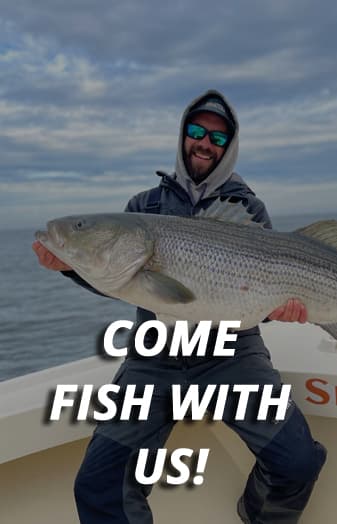Chesapeake Bay Bull Redfish!
Redfish, red drum, old drum, channel bass or whatever anglers call these explosive, hard fighting sportfish one thing is for sure every angler can appreciate these inshore monsters! The pursuit begins as the low pressure systems and spring rains come to an end in the Chesapeake Bay region. The last of the migratory Striped bass make their exit out of the bay and head north to make room for the next apex, inshore species to make their spring debut, the Red drum. These giants (often times exceeding 40+ pounds) are pursued up and down the East Coast and Gulf Coast of the United States. For the light tackle, fly, or bait fisherman the Red drum are an excellent game fish to target. While fisheries biologists, government agencies, social media and keyboard quarterbacks warn of other sportfish species being under extreme stress or suffering from a declining population, the Red drum population (under current regulations) seems to be flourishing. For anglers, this means the chance of encountering one of these trophy fish is very likely if you go looking in the right places at the right time.
Environmental Cues
The season begins with the Blue crabs. The importance of these critters should not be overlooked. The blue crab is critical in the life cycles of many species of fish that call the Chesapeake Bay home. Crabs leave their winter homes in the mud as water temperatures increase in preparation for molting. Here is where the Red drum first makes its appearance in the bay. When water temps are in the low 60’s the bulls will consistently be shallow rooting around like herds of pigs in search of their next meal. After a few short weeks, fish will move out in search of more comfortable water temps and better sources of bait for the hot summer months to follow.
Where to start the Hunt
Starting your season in the many miles of shallow flats, creeks, and backwaters of the Bay is your best bet for success. These fish are on the hunt for blue crabs, shrimp, and baitfish all seeking comfortable water temps themselves. Following the fish out of the shallows (with the bait) as water temperatures increase and focusing your efforts on fishing the shoals, creek mouths, oyster bars, rock piles, jetties, and the vast amounts of man made structure in the Bay can be extremely productive. Like many Chesapeake Bay species, structure, either natural or man-made, provide excellent ambush points for predators looking for their next easy meal.
Indicator Species
Bull redfish give themselves away in many different ways. Indicator species such as cownose rays, bunker schools, bluefish, and small Spanish mackerels are sometimes just as important to look for as the fish themselves. Unlike their cousins in the south, the likely hood to encountering these fish “tailing” in the shallows is not the norm but the exception. So hunting for other species that drum tend to be around can be a very productive tactic throughout the season.
Rigging, knots, and baits
Whether it’s with a fly rod, spinning or conventional gear with artificial lures or bait, you need to be ready when chasing these giants. I prep my tackle and gear on charters for the biggest fish I hope to catch, especially for these fish that will be more than likely over the slot limit and have to be released. Fly rods from 9-11wt matched with an appropriate reel with a solid drag, stout leader and adequate backing are preferred. Casting jigs, poppers, and artificials on 7’ Medium Heavy or Heavy rods paired with a Shimano reel is my go to set-up in the bay.
For making leaders I prefer fluorocarbon for its abrasion resistance around structure and sharp objects where the Bull reds tend to hold. Knots are one of important nuances as a charter Captain. Some days you may only have a few shots at fish so losing a fish to knot failure is not an option. Connections from braid to leader material such as fluorocarbon or monofilament can be a very touchy subject among anglers. The go-to knot for many anglers is the double uni knot. This is a great knot and when I am not casting I prefer it because of its simplicity and how quick it can be tied. When casting I have converted over the years to the FG knot. Many anglers shy away from this knot but with a little bit of practice and watching a few videos online I highly recommend it. This knot creates a seamless, smooth connection with unparalleled strength.
Drum are typically a very aggressive fish when encountered. As long as your bait artificial, cut bait, or live offering is in the zone odds are they are not going to refuse it. Paddle tails are some of my favorite artificial lures to use when search or trying to locate fish. Easy to use and not a lot of effort goes into the plastic to make it fish properly. The Hogy Lure Company’s Pro Tail soft plastics, various bucktail style hair jigs, and poppers great choices when hunting bull reds. Almost all the baitfish that call the Chesapeake home are good choices when bottom fishing but fresh Atlantic Menhaden (bunker) is always are excellent bait to fish.
Catch & Release and Proper fish handling
Bull Red drum are a catch and release species in the Chesapeake Bay. Whether you are in Maryland or Virginia all of these large fish will be over the slot limit. Taking steps for a healthy release of these trophy fish is critical. I use a large catch and release style landing net for these fish. Leaving the fish in the water boat side until a camera or cell phone is ready for a quick picture. Summer water temperatures in the Chesapeake are very warm so minimizing the amount of time these fish spend out the water is important. Holding the fish with a landing tool such a Boga grip and allowing the fish to catch its breath after a long battle is best way to ensure a healthy release. I attach my Boga grip to a tether and allow fish to “hang out” swimming with the boat until they tell you its time to go, especially when anchored. If the fish goes belly up when anglers are on anchor its very difficult to pull everything in and chase the fish down. To sum it up, be quick about a picture of your trophy catch and get the fish back in the water safely and as quickly as possible. This will certainly help the future of these old fish and provide an exciting fishery for generations of anglers to come.
Capt. Tyler Nonn operates Tidewater Charters, a light tackle and fly fishing guide service based in the Chesapeake Bay. Capt. Nonn targets the Bay’s inshore big game species for the majority of the year but spends his winters in the Florida Keys pursuing all the species the Keys has to offer.



